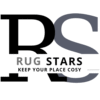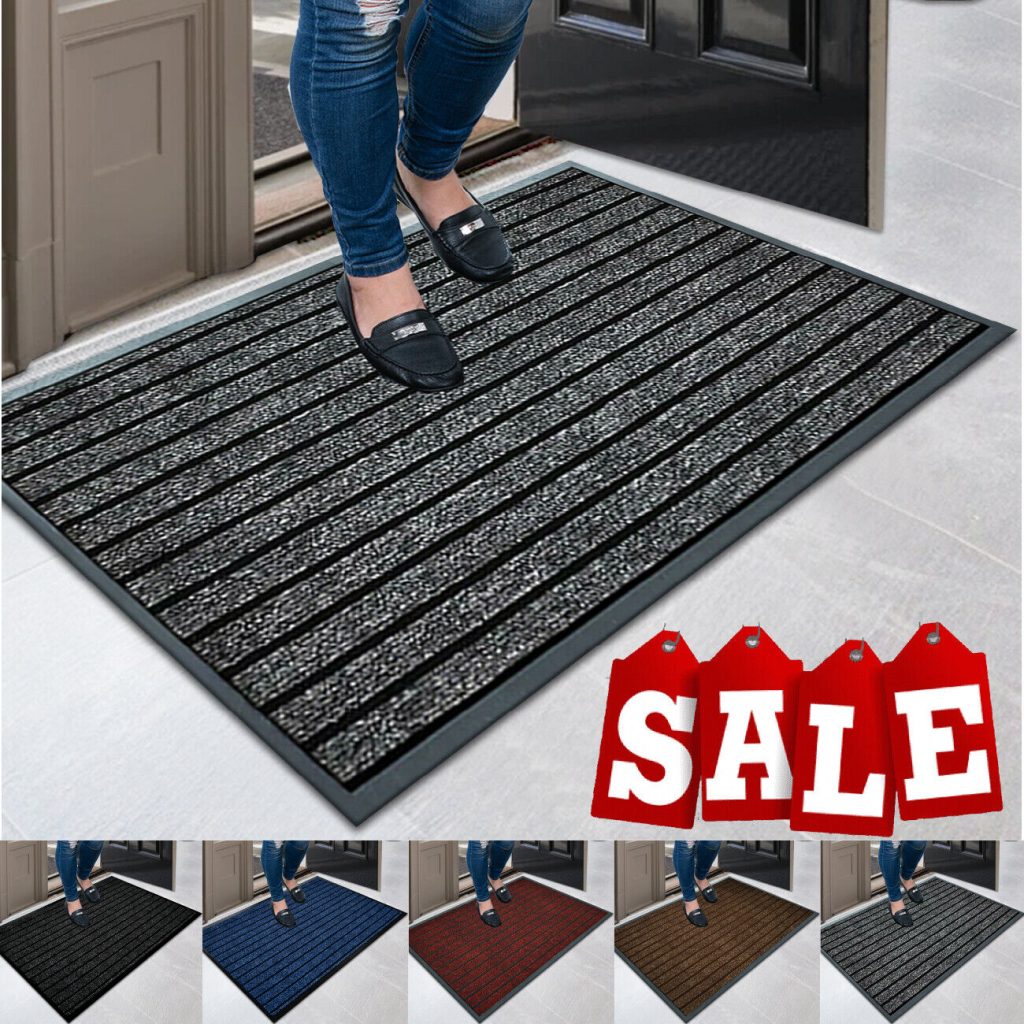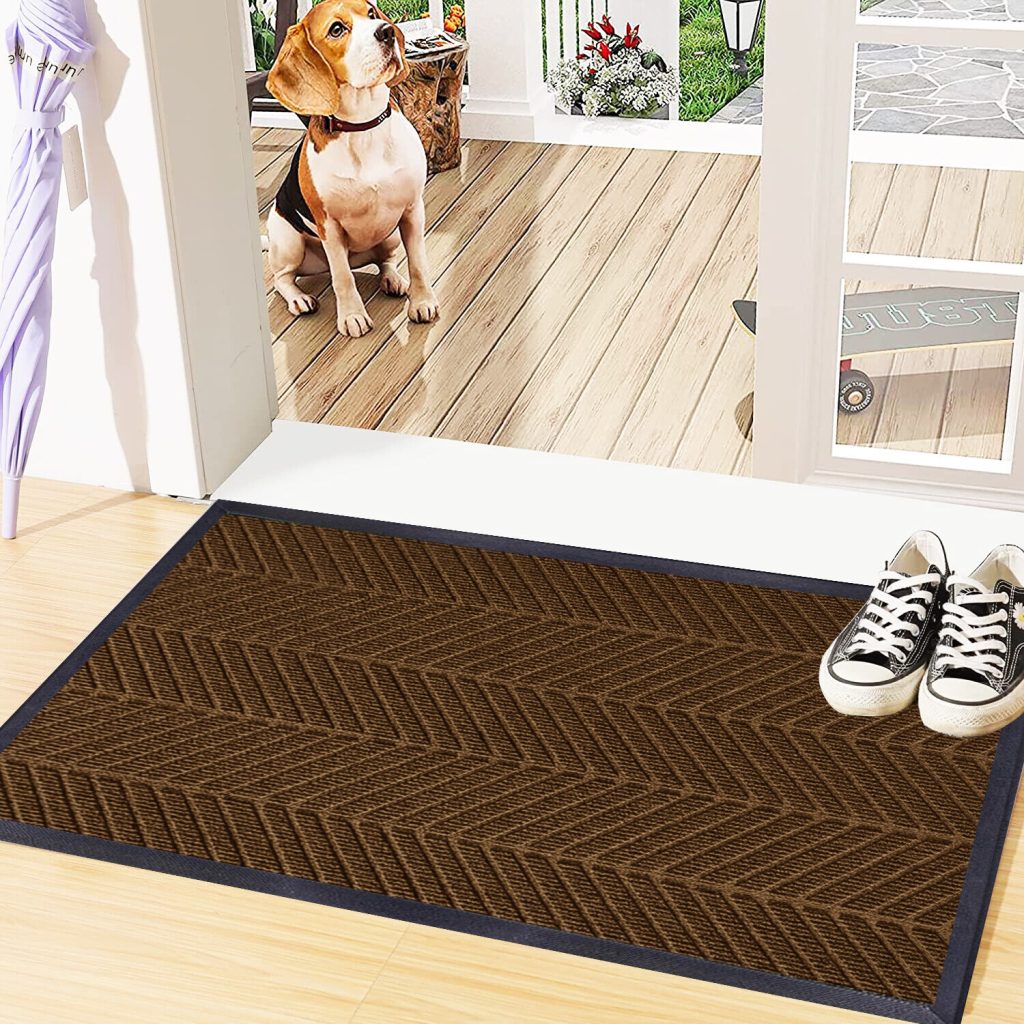Entrance mats are essential for maintaining cleanliness, protecting floors, and enhancing safety in any home, particularly in the UK where unpredictable and often damp weather makes the right choice crucial. This comprehensive guide delves into the specifics of outdoor and indoor rubber-backed entrance mats, helping you select the perfect solution for your home’s unique needs and the challenges of the British climate.
Understanding Rubber Backed Entrance Mats: What They Are and Why They Matter for UK Homes
Rubber-backed entrance mats are specifically designed to combine a highly effective top surface for dirt and moisture trapping with a robust, flexible rubber base. This innovative design offers superior performance, making them a popular and practical choice for modern homes across the UK.
Key Features and Benefits of Rubber Backed Mats:
- Exceptional Durability: The rubber backing acts as a protective shield, significantly extending the mat’s lifespan by guarding against wear and tear caused by constant foot traffic and environmental exposure. This is particularly valuable in high-traffic areas and during inclement weather.
- Superior Slip Resistance: Engineered to grip firmly onto various floor surfaces, the rubber backing dramatically reduces the risk of slips and falls. This critical safety feature is invaluable in preventing accidents, especially when floors are wet from rain or spills.
- Effective Waterproofing: One of the most significant advantages, especially in the UK, is the rubber’s ability to prevent absorbed moisture from seeping through to your underlying floors. This protects wooden, laminate, and tiled surfaces from water damage, dampness, and potential mould growth, keeping your interiors dry and pristine.
- Efficient Dirt and Moisture Management: These mats excel at trapping mud, rain, snow, and general outdoor debris, ensuring your interior floors remain clean and dry. Their ability to contain mess makes them an indispensable tool for maintaining home hygiene.
- Versatile Placement: The inherent flexibility of rubber-backed mats allows for easy positioning on a wide range of floor types and in various locations, adapting effortlessly to your home’s layout.
For UK homeowners, these durable and practical rubber-backed entrance mats are an invaluable investment. They efficiently manage the ingress of mud, rain, and other environmental elements, preventing them from being tracked throughout your living spaces. Their robust construction and non-slip properties ensure that your floors stay protected and your home remains a safer, cleaner environment, even through the wettest winters and muddiest springs.
Key Differences Between Outdoor and Indoor Rubber Backed Entrance Mats for UK Conditions
While both outdoor and indoor entrance mats feature a beneficial rubber backing, their material composition, thickness, and overall design are specifically tailored to meet the distinct demands of their respective environments. Understanding these differences is crucial for selecting the most effective entrance mats for your home.
Comparative Analysis: Outdoor vs. Indoor Rubber Backed Entrance Mats
| Aspect | Outdoor Rubber Backed Mats | Indoor Rubber Backed Mats |
|---|---|---|
| Primary Material | Heavy-duty, weather-resistant fibres like tough coir (coconut fibre) or coarse polypropylene. | Softer, absorbent fibres such as plush nylon, polyester, or velour. |
| Pile Thickness | Thicker, coarser pile designed for aggressive scraping of tough dirt, mud, and debris. | Thinner to medium pile, optimised for gentle moisture absorption and trapping fine dust. |
| Weather Resistance | Engineered to withstand harsh elements including heavy rain, frost, snow, and prolonged UV exposure without degrading. | Less resistant to extreme weather; primarily focused on managing indoor moisture and dirt. |
| Cleaning Efficiency | High scraping ability to effectively remove stubborn debris, grit, and mud from footwear. | Excellent at absorbing residual moisture, trapping fine dust particles, and providing a soft surface. |
| Overall Durability | High resistance to environmental wear, fading, and degradation from constant exposure to the elements. | Moderate durability, designed for sheltered indoor areas where they are less exposed to harsh conditions. |
For the typical UK climate, characterised by wet winters and often damp summers, outdoor mats must demonstrate superior performance under constant moisture and dirt exposure. They are the first line of defence against the elements. In contrast, indoor mats are designed to maintain internal floor cleanliness and safety, absorbing any lingering moisture or fine dust that outdoor mats might miss, all while enhancing the interior aesthetic without causing wear or creating slipping hazards.
Choosing the Right Material for UK Conditions: What Works Best Outdoors and Indoors
Selecting the appropriate material for your rubber-backed entrance mats is paramount for optimal performance in the varying UK weather. Each material offers distinct advantages tailored for specific uses.
Outdoor Rubber Backed Mats:
- Coir (Coconut Fibre): A natural, highly abrasive, and environmentally friendly choice, coir is exceptional at scraping off mud, dirt, and grit from shoes. Its stiff fibres are incredibly effective at removing heavy debris, making it ideal for the main entrance. When paired with a rubber backing, it ensures the mat stays firmly in place, even during strong winds and heavy rainfall, which is essential during wet UK seasons.
- Polypropylene: A synthetic and highly durable option, polypropylene is naturally mould-resistant, quick-drying, and remarkably resilient. These properties make it an excellent choice for outdoor use in the wet UK weather, as it resists water absorption and dries quickly, preventing odours and degradation. Its robust nature means less wear and tear from constant use and exposure.
Indoor Rubber Backed Mats:
- Nylon: Known for its softness and durability, nylon fibres are highly effective at absorbing moisture and trapping fine dust without sustaining damage. It’s an ideal material for indoor entrance mats where comfort underfoot and superior absorbency are desired. Nylon mats provide a clean and welcoming transition from outdoors to indoors.
- Polyester or Velour: These materials offer a smooth, luxurious finish that gently removes residual moisture and fine dirt from footwear. They are perfect for complementing interior décor, adding a touch of elegance while effectively preventing slips on smooth indoor surfaces. Their soft texture makes them suitable for hallways, mudrooms, and other internal entry points.
The choice of material should be strategically aligned with the doorway’s exposure and the expected foot traffic. For front entrances with heavy footfall and direct exposure to the elements, tough coir or polypropylene outdoor door mats are highly recommended. For internal areas such as hallways, mudrooms, and kitchen entryways, cushioned nylon or soft velour indoor door mats offer the best combination of comfort, moisture control, and aesthetic appeal. These choices ensure your home benefits from maximum cleanliness and protection.
Strategic Placement of Entrance Mats: Maximizing Functionality and Home Aesthetics
The strategic placement of your rubber-backed entrance mats is just as important as their selection. Correct positioning ensures optimal functionality, safeguards your floors, and enhances the overall aesthetics of your home, especially in the variable UK climate.
Outdoor Placement Strategies:
- First Line of Defence: Always position your outdoor mats directly in front of the main door, back door, or any entry point from outside. This ensures that the initial and heaviest layers of dirt, mud, and debris are scraped off shoes before anyone steps inside.
- Ample Coverage: For wider doorways or patio entrances, consider using larger mats or combining multiple mats to create an extended dirt-trapping zone. This provides maximum protection against the UK’s often damp and muddy weather, ensuring no dirty footprints make it indoors.
- Extend Beyond the Door’s Reach: Ensure the outdoor mat extends sufficiently beyond the swing of the door. This allows visitors to fully step onto the mat and wipe their feet effectively without stepping directly onto the clean interior floor.
Indoor Placement Strategies:
- Capture Residual Moisture: Place indoor mats just inside the door. Their primary role is to absorb any residual moisture, fine dust, and pollen that the outdoor mat might have missed, acting as a final barrier to cleanliness.
- Protect Vulnerable Areas: Extend mat coverage to high-traffic indoor areas prone to moisture and dirt, such as hallways, mudrooms, and kitchen entryways. These areas are particularly vulnerable to wet feet and accidental spills.
- Aesthetic Integration: Select indoor mats that not only function well but also complement your room’s interior style and colour scheme. An attractive mat can add significant aesthetic value, tying into your home decor while providing essential floor protection and enhancing safety.
Effective Combination: The Layered Approach for UK Homes
For comprehensive floor protection against the UK’s typical dirt and moisture challenges, pairing a coarse heavy-duty outdoor mat with a softer, more absorbent indoor mat is the optimal strategy. This layered approach ensures a two-stage cleaning process: the outdoor mat aggressively scrapes off the bulk of the debris, and the indoor mat then captures any remaining dampness and fine particles. This system guarantees a cleaner, safer, and more welcoming home entrance, no matter the weather.
Simple Maintenance and Care Tips to Extend the Life of Your Entrance Mats
Regular maintenance is key to preserving the effectiveness and longevity of your rubber-backed entrance mats. Proper care ensures they continue to trap dirt and moisture efficiently, keeping your home clean and safe for years to come.
Cleaning Routines for Different Mat Types:
- Outdoor Mats:
- Regular Debris Removal: For general upkeep, simply shake or beat your outdoor mat vigorously to dislodge loose dirt, leaves, and other debris. Do this regularly, especially after heavy foot traffic or adverse weather.
- Washing Polypropylene Mats: Synthetic polypropylene mats can be easily hosed down with water. Allow them to air dry thoroughly before repositioning to prevent mildew.
- Care for Coir Mats: While coir mats are incredibly effective at scraping, avoid soaking natural coir excessively as this can lead to rot and shorten their lifespan. Instead, brush off dry mud and use a stiff brush for more stubborn dirt.
- Indoor Mats:
- Frequent Vacuuming: Vacuum indoor mats regularly to remove fine dust, pet hair, and absorbed moisture. This prevents dirt from settling deep into the fibres.
- Spot Cleaning: For spills or visible stains, spot clean immediately using a mild detergent and a damp cloth. Avoid harsh chemicals that could damage the mat fibres or rubber backing.
- Air Out: Periodically take your indoor mats outside to air out, especially if they are in high-moisture areas like mudrooms.
Seasonal Care for Enhanced Durability:
- Winter Protection: If you live in an area prone to extreme winter freezes, consider storing certain outdoor mats indoors or under shelter if they are not specifically rated for frost resistance. This can prevent material brittleness and cracking of the rubber backing.
- Even Wear Distribution: Rotate your entrance mats periodically, especially in high-traffic areas. This helps distribute wear evenly across the mat surface, extending its functional life.
Troubleshooting Common Mat Issues:
- Odour: If a mat develops an unpleasant odour, it’s often due to excessive moisture retention. Air out the mat thoroughly in a well-ventilated area. For persistent odours, a deep clean with an appropriate cleaner (following manufacturer instructions) might be necessary.
- Wear and Tear: Mats showing signs of significant wear, such as threadbare patches or matted fibres, should be replaced. A worn-out mat loses its effectiveness in trapping dirt and absorbing moisture, compromising your home’s cleanliness and safety.
- Slippage: If your rubber-backed mat starts to lose its grip, first ensure the underside of the mat and the floor surface are clean and dry. Dirt or residue can reduce friction. If the problem persists, the rubber backing might be deteriorating, or you could consider using an additional non-slip underlay for added security.
By implementing these simple care routines, you can significantly prolong the life and effectiveness of your entrance mats, ensuring they continue to provide excellent floor protection and maintain a welcoming, clean home environment.
Comparing Outdoor vs Indoor Rubber Backed Entrance Mats: Which Fits Your Home Best?
To make an informed decision for your UK home, a direct comparison of the distinct features of outdoor and indoor rubber-backed entrance mats is essential. This table summarises their primary characteristics and typical use cases.
| Feature | Outdoor Rubber Backed Entrance Mats | Indoor Rubber Backed Entrance Mats |
|---|---|---|
| Primary Purpose | Aggressive scraping of heavy dirt, mud, grit, and significant debris from shoes. | Absorbing residual moisture, trapping fine dust, and preventing slips on interior floors. |
| Material Examples | Hard-wearing coir, resilient polypropylene, durable rubber blends. | Soft yet absorbent nylon, plush polyester, elegant velour. |
| Weather Resistance | High – specifically designed for continuous exposure to rain, snow, frost, and UV rays, maintaining performance in harsh conditions. | Moderate – best suited for sheltered indoor environments, not designed for direct exposure to severe outdoor weather. |
| Slip Resistance | High due to rugged, textured rubber backing and often heavier construction, providing excellent grip on outdoor surfaces. | High due to smooth, non-slip rubber backing, ensuring stability on various indoor floor types like laminate, tile, or wood. |
| Thickness & Texture | Thick, coarse, and abrasive fibres, specifically engineered for maximum scraping action. | Thin to medium pile with soft, absorbent fibres, designed for comfort and fine particle trapping. |
| Maintenance Needs | Requires shaking, hosing down (for synthetic types), or stiff brushing; occasional deep cleaning. | Regular vacuuming, prompt spot cleaning for spills, and occasional airing out. |
| Typical UK Use Case | Front entrances, back doors, garden sheds, patios, conservatory entrances – wherever outdoor elements are tracked in. | Hallways, mudrooms, kitchen entryways, utility rooms, and other interior spaces vulnerable to moisture and dirt. |
| Longevity | Designed for long-lasting performance even under challenging, harsh outdoor conditions. | Durable under moderate indoor use, maintaining appearance and function over time. |
Use Case Example for a Typical UK Household: Imagine a rainy autumn day. A homeowner would benefit immensely from a robust coir outdoor door mat positioned at their front door. This mat would effectively scrape off the bulk of the mud and wet leaves from shoes before entering. Just inside, a soft, absorbent nylon indoor door mat would then capture any residual moisture and fine dirt, ensuring that tiled or wooden floors remain dry, clean, and slip-free. This dual-mat strategy provides unparalleled floor protection and enhances home cleanliness.
Final Thoughts: Why Every UK Home Benefits from Both Indoor and Outdoor Rubber Backed Mats
For comprehensive protection against the UK’s frequently wet, muddy, and unpredictable conditions, a combined use of both outdoor and indoor rubber-backed entrance mats represents the most effective and optimal solution. Outdoor mats act as your home’s crucial first line of defence, tirelessly tackling the bulk of dirt, grit, and moisture before it ever crosses your threshold. They are designed to withstand the elements and aggressively scrape away debris, safeguarding your exterior entry points.
Complementing this, indoor mats play a vital role by capturing any residual dampness, fine dust, and stray particles, ensuring your interior floors remain pristine and significantly improving overall safety by preventing slips on wet surfaces. This synergistic, layered approach ensures maximum cleanliness, preserves your flooring, and creates a more hygienic and welcoming environment for residents and guests alike.
At Rugstars UK, we understand the specific challenges and needs of UK homes. That’s why we provide an expertly curated selection of durable, slip-resistant rubber-backed entrance mats designed to perfectly balance superior functionality with modern style. Explore our extensive range and find the ideal outdoor and indoor solutions to match your home’s aesthetic and practical requirements. Visit Rugstars.co.uk today to discover the perfect entrance mats that will enhance your entranceway’s cleanliness, appearance, and protection, ensuring your home stays welcoming and spotless, no matter what the British weather brings.
FAQ: Choosing and Maintaining Your Rubber Backed Entrance Mats
What is the main difference between outdoor and indoor rubber-backed entrance mats?
Outdoor rubber-backed mats are designed with heavy-duty, abrasive fibres like coir or polypropylene to aggressively scrape off mud, grit, and large debris, and are built to withstand harsh weather conditions. Indoor mats, conversely, feature softer, absorbent fibres such as nylon or polyester to trap fine dust and absorb residual moisture, focusing on protecting interior floors and enhancing comfort.
Why is a rubber backing important for entrance mats in the UK?
A rubber backing is crucial for UK homes because it provides superior slip resistance, preventing mats from shifting on wet or smooth floors, thereby reducing the risk of accidents. It also acts as an effective waterproof barrier, stopping absorbed moisture from seeping through and damaging underlying flooring, which is essential given the UK’s often damp climate.
Which material is best for an outdoor entrance mat in a wet UK climate?
For a wet UK climate, coir (coconut fibre) is excellent for its natural abrasive qualities that scrape off mud and dirt effectively. Alternatively, polypropylene is a superb synthetic choice, being mould-resistant, quick-drying, and highly durable against rain, frost, and UV exposure, making it ideal for continuous outdoor use.
How often should I clean my rubber-backed entrance mats?
Outdoor mats should be shaken or beaten regularly to remove loose debris, and hosed down if they are polypropylene. Indoor mats benefit from frequent vacuuming (daily in high-traffic areas) and spot cleaning as needed. Seasonal care and rotating mats can also extend their life and effectiveness.
Can I use an outdoor mat indoors or vice versa?
While technically possible, it’s not recommended for optimal performance or longevity. Outdoor mats used indoors can be too abrasive for delicate floors and may not absorb fine moisture effectively. Indoor mats used outdoors will quickly degrade due to exposure to harsh weather and won’t effectively scrape off heavy dirt, potentially leading to a shorter lifespan and reduced protection for your home.



